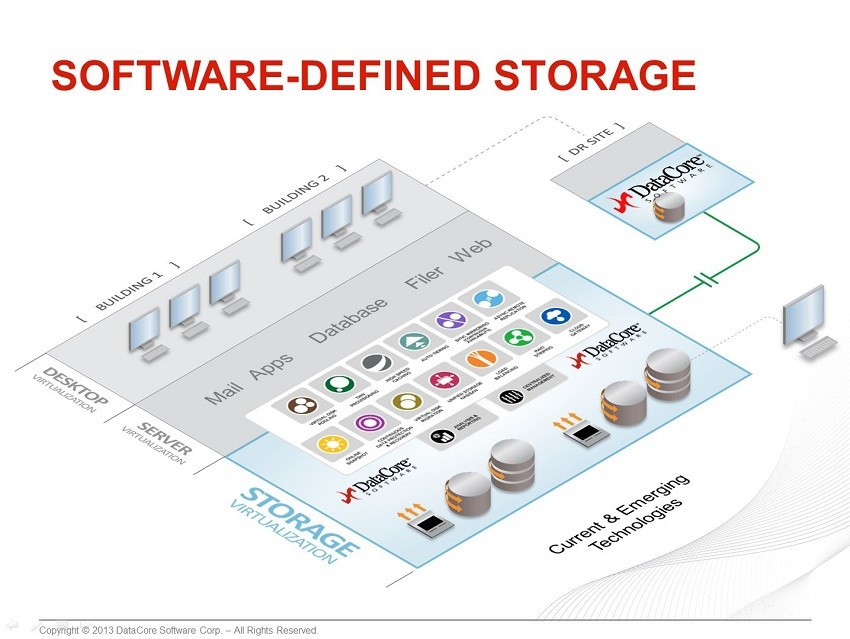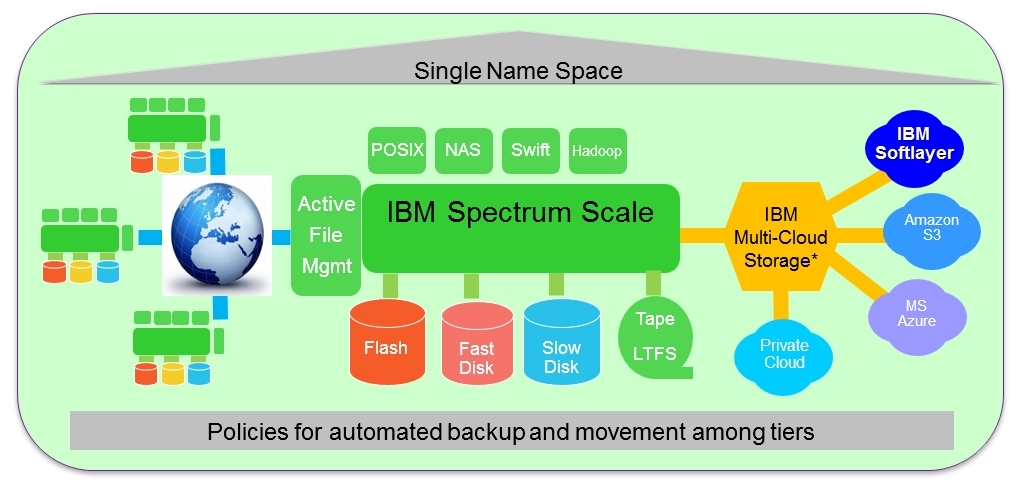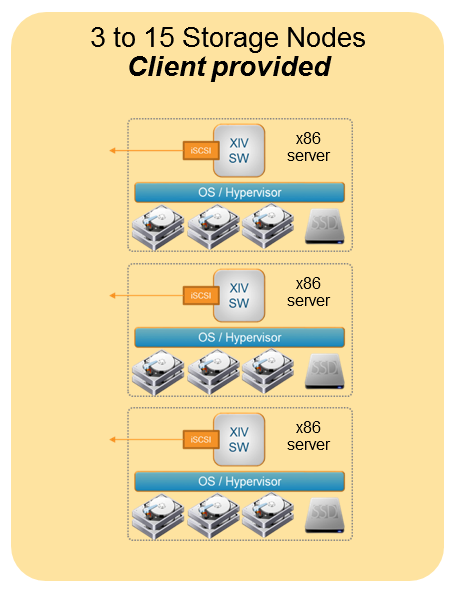Not a single iron: IBM Software Defined Storage
The concepts and causes of SDS (Software Defined Storage) - storage systems based on software functionality, sometimes without reference to a specific architecture or hardware platform, lie primarily in the requirements of companies. Today's business of any company is moving more and more towards the development of analytics, BigData, clouds and social media, which do not mutually exclude each other, but complement the overall solution architecture with their requirements. So for example, the most effective implementation of BigData can not do without the use of analytics. Social media can no longer exist without cloud services and their close integration with the interfaces of social platforms.

')
As a result, we come to the fact that the influence of technologies and customer requirements affects the business as a whole, requiring faster access to insights, leading to increased requirements for the development of new applications and the emergence of new competitors. And this is all against the background of the huge growth of information volumes, the emergence of new tasks and the introduction of the cloud as an element of infrastructure.
Against this background, it becomes harder to describe the requirements for using storage systems for the whole range of new tasks and conditions. There is a need to release data from the limitations of the hardware platform and rebuild them to work with new business processes and applications. Service requirement levels are misleading IT managers who are accustomed to standard storage methods, creating situations of “blind” adding volumes, isolating data in storage “islands”, unreasonable duplication of information, which in turn leads to an increase in the maintenance cycle of storage networks, increase in the price of solutions, complexity of processes within companies and lack of infrastructure flexibility.
It is because of the emergence of such problems and tasks that the concept of SDS has arisen. According to IDC, Software Defined Storage is a bundle of storage software that can be installed on any Commodity server (x86 platform, hypervisor or cloud) or another computing platform, and provide a full range of services for storing and integrating existing data placement resources, allowing Mobile move and redistribute storage capacity between these resources, depending on requirements.
The main attributes of SDS are:
- work on the commodity platform - without specialized hardware platforms or components;
- full set of storage services - equivalent to traditional hardware systems;
- association (federation) of a set of existing storage resources: internal disks, cloud, other external storage systems or cloud / object platforms.
SDS uses:
- “Shared nothing” architecture - a distributed computing architecture, in which any node of a computing node is self-sufficient;
- Horizontally or vertically scalable model.
Software Defined Storage is divided into three groups: based on file access, object access and block access.
IBM identifies three main characteristics of SDS in addition to the above:
Flexibility :
Automatically customizable enterprise-class solution that allows you to deploy cloud-based storage infrastructure in minutes.
Control :
In-depth analysis and optimization “on permise” (at customer sites) of storage systems and cloud storage systems - safety, price, performance - using analytics.
Efficiency :
Better automation of the processes of placing and managing data between storage media, storage systems, clouds to achieve both levels of service agreement and reduce the price of the solution.
IBM announced a new line of software that covers certain tasks solved by SDS. The common name is IBM Spectrum Storage . It includes both a set of already known technologies, and the latest developments.
Of the known ones, IBM SAN Volume Controller stands out, which has been on the market since 2004 and successfully helps customers consolidate storage volumes and get rid of the problems of simultaneous storage management from different vendors and different classes within the same infrastructure, and also simplifies the allocation of volumes, data movement between different hardware platforms without stopping the work of the hosts, adding storage levels and automating the processes of moving and migrating between them. SVC allows you to “hide”, in fact, any Fiber Channel storage system and behind the interface of the appliance itself, and add functionality to virtualized storages, including the functionality of data compression on the fly, even those storage systems that never knew how to do.
In the context of the new family of software SAN Volume Controller will be called IBM Spectrum Virtualize .
IBM Spectrum Controll - software for automating the management and optimization of storage infrastructure with the ability to provide self-service portals, in-depth analytics and tuning recommendations. Previously known as Virtual Storage Center, which includes a significantly redesigned and improved Tivoli Productivity Center.
IBM Spectrum Protect is an enhanced version of Tivoli Storage Manager, which provides a system of backups and archiving on schedules, load intensity and criteria. Of course, it was not done without data verification algorithms and recovery technologies. Full collaboration support is embedded in the very concept of the Spectrum Storage product family. This is also the case with the modified IBM Spectrum Archive , which is based on the Liner Tape File System database, which allows access to data on tape as a network folder or network mounted drive.
In addition to the products mentioned above, the family includes two more “newbies” - IBM Spectrum Scale and IBM Spectrum Accelerate . The first is based on GPFS and is a complete platform with open APIs for tight integration with Social Media, Hadoop, IBM BigInsight. Allows you to combine both storage and local server drives. It has the ability to consolidate the volume from different sources up to the creation of multi-level storage based on volume pools consisting of local disks, a storage network, file or object storage, and cloud resources. Spectrum Scale interfaces allow you to create files in a single namespace and at the same time store data depending on the type, date, user or group at different levels. Automatically transfer information between physical resources up to transfer to the cloud or to the Spectrum Archive after the expiration date. Today, the same Hadoop fully supports and can be deployed based on the Spectrum Scale file system instead of native HDFS.

The solution architecture today allows you to scale to values in Yottabytes and has no physical limitations on the location of hardware elements, allowing you to assemble geographically distributed systems into one management interface with the same set of policies and rules.
The second product, IBM Spectrum Accelerate, is a software implementation of the unique GRID architecture that underlies the XiV system. It supports the entire set of functions of the XiV storage system; it can act as a full-fledged partner in setting up remote mirroring. In the same way as the hardware platform, it comes in a useful volume. The user will not need to think about the type of raid, the number of disks in the raid group, or how to properly configure the system to work with a particular load. IBM Spectrum Accelerate uses any server on the customer’s site as a hardware platform. This means that you do not need to buy disks or storage, it is enough to select at least three servers that meet the minimum requirements, and get a full-fledged storage system that has all the characteristics of the hardware counterpart. It is an ideal solution for users with heterogeneous loads and high risks.

Two new products in the Spectrum Storage line-up are only part of a future development strategy. All the listed functionality and all products mentioned above are more or less available in the IBM SoftLayer cloud and are ready for use by customers. IBM has also launched a new PCI-E Flash product based on Flash System 900 technology and a system with integrated control and a wide range of Flash System V9000 functionality. The previous generation of such systems showed the highest results on independent testing and a number of Ukrainian customers.
Strategy and steps to the development of Software Defined Storage are one of the most promising in the IT market. Today’s businesses are more or less exposed to the problems of management, control and analytics of infrastructures, which is significantly complicated by the large number of independent hardware platforms that perform the same function, but for different tasks. The ability to simplify, automate, optimize and analyze such infrastructures plays an important role in the performance of any company’s CAPEX and OPEX.

')
As a result, we come to the fact that the influence of technologies and customer requirements affects the business as a whole, requiring faster access to insights, leading to increased requirements for the development of new applications and the emergence of new competitors. And this is all against the background of the huge growth of information volumes, the emergence of new tasks and the introduction of the cloud as an element of infrastructure.
Against this background, it becomes harder to describe the requirements for using storage systems for the whole range of new tasks and conditions. There is a need to release data from the limitations of the hardware platform and rebuild them to work with new business processes and applications. Service requirement levels are misleading IT managers who are accustomed to standard storage methods, creating situations of “blind” adding volumes, isolating data in storage “islands”, unreasonable duplication of information, which in turn leads to an increase in the maintenance cycle of storage networks, increase in the price of solutions, complexity of processes within companies and lack of infrastructure flexibility.
It is because of the emergence of such problems and tasks that the concept of SDS has arisen. According to IDC, Software Defined Storage is a bundle of storage software that can be installed on any Commodity server (x86 platform, hypervisor or cloud) or another computing platform, and provide a full range of services for storing and integrating existing data placement resources, allowing Mobile move and redistribute storage capacity between these resources, depending on requirements.
The main attributes of SDS are:
- work on the commodity platform - without specialized hardware platforms or components;
- full set of storage services - equivalent to traditional hardware systems;
- association (federation) of a set of existing storage resources: internal disks, cloud, other external storage systems or cloud / object platforms.
SDS uses:
- “Shared nothing” architecture - a distributed computing architecture, in which any node of a computing node is self-sufficient;
- Horizontally or vertically scalable model.
Software Defined Storage is divided into three groups: based on file access, object access and block access.
IBM identifies three main characteristics of SDS in addition to the above:
Flexibility :
Automatically customizable enterprise-class solution that allows you to deploy cloud-based storage infrastructure in minutes.
Control :
In-depth analysis and optimization “on permise” (at customer sites) of storage systems and cloud storage systems - safety, price, performance - using analytics.
Efficiency :
Better automation of the processes of placing and managing data between storage media, storage systems, clouds to achieve both levels of service agreement and reduce the price of the solution.
IBM announced a new line of software that covers certain tasks solved by SDS. The common name is IBM Spectrum Storage . It includes both a set of already known technologies, and the latest developments.
Of the known ones, IBM SAN Volume Controller stands out, which has been on the market since 2004 and successfully helps customers consolidate storage volumes and get rid of the problems of simultaneous storage management from different vendors and different classes within the same infrastructure, and also simplifies the allocation of volumes, data movement between different hardware platforms without stopping the work of the hosts, adding storage levels and automating the processes of moving and migrating between them. SVC allows you to “hide”, in fact, any Fiber Channel storage system and behind the interface of the appliance itself, and add functionality to virtualized storages, including the functionality of data compression on the fly, even those storage systems that never knew how to do.
In the context of the new family of software SAN Volume Controller will be called IBM Spectrum Virtualize .
IBM Spectrum Controll - software for automating the management and optimization of storage infrastructure with the ability to provide self-service portals, in-depth analytics and tuning recommendations. Previously known as Virtual Storage Center, which includes a significantly redesigned and improved Tivoli Productivity Center.
IBM Spectrum Protect is an enhanced version of Tivoli Storage Manager, which provides a system of backups and archiving on schedules, load intensity and criteria. Of course, it was not done without data verification algorithms and recovery technologies. Full collaboration support is embedded in the very concept of the Spectrum Storage product family. This is also the case with the modified IBM Spectrum Archive , which is based on the Liner Tape File System database, which allows access to data on tape as a network folder or network mounted drive.
In addition to the products mentioned above, the family includes two more “newbies” - IBM Spectrum Scale and IBM Spectrum Accelerate . The first is based on GPFS and is a complete platform with open APIs for tight integration with Social Media, Hadoop, IBM BigInsight. Allows you to combine both storage and local server drives. It has the ability to consolidate the volume from different sources up to the creation of multi-level storage based on volume pools consisting of local disks, a storage network, file or object storage, and cloud resources. Spectrum Scale interfaces allow you to create files in a single namespace and at the same time store data depending on the type, date, user or group at different levels. Automatically transfer information between physical resources up to transfer to the cloud or to the Spectrum Archive after the expiration date. Today, the same Hadoop fully supports and can be deployed based on the Spectrum Scale file system instead of native HDFS.

The solution architecture today allows you to scale to values in Yottabytes and has no physical limitations on the location of hardware elements, allowing you to assemble geographically distributed systems into one management interface with the same set of policies and rules.
The second product, IBM Spectrum Accelerate, is a software implementation of the unique GRID architecture that underlies the XiV system. It supports the entire set of functions of the XiV storage system; it can act as a full-fledged partner in setting up remote mirroring. In the same way as the hardware platform, it comes in a useful volume. The user will not need to think about the type of raid, the number of disks in the raid group, or how to properly configure the system to work with a particular load. IBM Spectrum Accelerate uses any server on the customer’s site as a hardware platform. This means that you do not need to buy disks or storage, it is enough to select at least three servers that meet the minimum requirements, and get a full-fledged storage system that has all the characteristics of the hardware counterpart. It is an ideal solution for users with heterogeneous loads and high risks.

Two new products in the Spectrum Storage line-up are only part of a future development strategy. All the listed functionality and all products mentioned above are more or less available in the IBM SoftLayer cloud and are ready for use by customers. IBM has also launched a new PCI-E Flash product based on Flash System 900 technology and a system with integrated control and a wide range of Flash System V9000 functionality. The previous generation of such systems showed the highest results on independent testing and a number of Ukrainian customers.
Strategy and steps to the development of Software Defined Storage are one of the most promising in the IT market. Today’s businesses are more or less exposed to the problems of management, control and analytics of infrastructures, which is significantly complicated by the large number of independent hardware platforms that perform the same function, but for different tasks. The ability to simplify, automate, optimize and analyze such infrastructures plays an important role in the performance of any company’s CAPEX and OPEX.
Source: https://habr.com/ru/post/302946/
All Articles